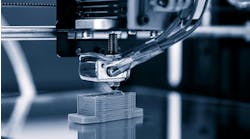As manufacturers settle into a new normal, it’s quite possible that robotics will play a far more powerful role. How soon could depend heavily on the application. According to a recent report by global tech market advisory firm ABI Research, COVID-19 has spotlighted a number of use cases for mobile robotics to successfully disinfect, monitor, surveille and move materials. In fact, ABI anticipates these use cases will propel the overall mobile robotics market to US$23 billion by 2021.
“Crises shift perceptions on what is possible regarding investment and transformative action on the part of both private and government actors. By the time the COVID-19 pandemic has passed, robots will be mainstreamed across a range of applications and markets,” says Rian Whitton, senior analyst at ABI Research.
As a leader in the autonomous mobile robots, San Jose, CA-based Fetch Robotics Inc. has noticed the interest in pandemic-induced interest and utilization, especially within its essential goods-centric customers. “Our customers are making a number of changes in use cases that adapt to the new conditions,” says CEO Melonee Wise. “From a scheduling and workflow perspective they are adjusting the type of trips such as shuttling goods between people to help with social distancing and reduce the risk of contamination between people.”As a cloud-based solution, Fetch was able to help its customers quickly reconfigure robot utilization remotely. Wise tells IndustryWeek they are also seeing new inbound business with firms in the electronics, pet care and medical device market sectors. Fetch is also working with strategic partners to address disinfection-based use cases in hospitals, office building, collaborative workspaces and large airports.
Traditional expansion
While ABI Research anticipates that traditional robotic deployments could lag, especially as manufacturers find their footing in a very unsure world, traditional industrial robots have evolved significantly in recent years. A key part of the reason why robots are steadily finding their way into today’s manufacturing environments is the ability to combine robotics with other evolving technologies like machine vision, machine learning and artificial intelligence.
AI is making robots applicable in much less structured situations, which is typical of most manufacturing environments, explains Vicarious Co-founder and CTO Dileep George. Vicarious has spent the past decade building and deploying highly adaptive AI algorithms for industrial robots.
“Dealing with these settings require accurate sensing of the world, and flexible and efficient action plans. It also requires a robust software stack that can be easily reconfigured for different applications, robot geometries, end-of-arm tools, and camera configurations,” he says. “Techniques that are data-efficient are likely to have a key advantage in these settings because they will be able to adapt quickly to ever-changing environments and task specifications. There is a really very long tail of applications, each of which are small volumes, and as AI gets smarter and more data-efficient, these tasks can be tackled.”
According to George, the opportunities are wide open with any process in an assembly line that involving picking up, manipulating or orienting objects correctly for insertion are ripe for automation. “Many of the tasks that were previously impossible for robotics are now within reach with AI. Of course, these tasks can be ordered in the range of difficulty from easy to impossible. Tasks that needed custom fixtures or elaborate machinery can now be tackled with just cameras, AI-software and standard robots that can be re-purposed for new variations of the task,” says George. “Some tasks are not yet feasible, such as handling flexible materials like wires and cloth. The trick is in identifying subsets that are feasible to attack while meeting the rest of the operational constraints of the assembly line.”
Moreover, with evolving deployment models like Vicarious’ robots-as-a-service that charges per unit of work done rather than a fixed capital expense, the historically large capital expenses and obsolete equipment issues are rapidly fading. “Robot-as-a-service labor is more predictable with consistent steady-state throughputs compared to human labor that can vary widely in availability and consistency,” says George.
The key to success? Taking the time upfront to understand the whole workflow and make sure that the robotics solution fits well into that environment. “Often there are unstated assumptions. Humans have very flexible intelligence, and as a result, we often take for granted some of the commonsense tasks that we perform unscripted on the assembly line,” says George. “Making a robot flexible is important, and so is knowing the limits of its flexibility, so that the total work can be accomplished efficiently with a combination of robots and people.”





